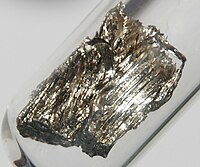
Photo from wikipedia
Abstract Hard/soft (H/S) Sr0.5Ba0.5Eu0.01Fe12O19/NixCuyZnwFe2O4 nanocomposites (NCs) were produced via a one-pot sol-gel auto-combustion procedure. Phase and surface analyses were performed using X-ray diffraction (XRD), scanning electron microscopy (SEM), transmission electron… Click to show full abstract
Abstract Hard/soft (H/S) Sr0.5Ba0.5Eu0.01Fe12O19/NixCuyZnwFe2O4 nanocomposites (NCs) were produced via a one-pot sol-gel auto-combustion procedure. Phase and surface analyses were performed using X-ray diffraction (XRD), scanning electron microscopy (SEM), transmission electron microscopy (TEM), and high-resolution transmission electron microscopy (HR-TEM). Magnetization measurements for H/S NCs with different x, y, and w ratios were investigated at two different temperatures (300 and 10 K). The M–H curves were not smooth for the different H/S NCs, revealing that the exchange interaction was incomplete. The derivative of the magnetization (dM/dH versus H) exhibited two separate peaks, confirming the non-coupled H/S mixtures. Maximum saturation magnetization (Ms) values of 93.9 and 63.1 emu/g were obtained at 10 and 300 K, respectively, for the H/S Sr0.5Ba0.5Eu0.01Fe11.99O19/Ni0.3Cu0.3Zn0.4Fe2O4 NC, which contained the highest content of Zn and the same contents of Ni and Cu within the soft magnetic phase. The calculated squareness ratios (SQR = Mr/Ms) were less than 0.5, indicating incomplete exchange coupling. The coercive field (Hc) of the produced NCs reached a maximum value of approximately 2485 Oe at 300 K and 2331 Oe at 10 K with a decrease in the Ms values to 56.9 emu/g at 300 K and 78.5 emu/g at 10 K for the H/S Sr0.5Ba0.5Eu0.01Fe11.99O19/Ni0.8Cu0.1Zn0.1Fe2O4 NC, which contained lower fractions of Zn and Cu and the highest fraction of Ni. The reflection/transmission-based waveguide approach was employed to investigate the electrodynamic properties of the H/S NC samples within a frequency band of 7–18 GHz. The reflection and transmission coefficients (S11/S21) were measured using a vector network analyzer (VNA) for the sample placed inside a waveguide. The frequency dispersions of the magnetic permeability and electric permittivity were calculated.
Journal Title: Journal of Materials Research and Technology
Year Published: 2021
Link to full text (if available)
Share on Social Media: Sign Up to like & get
recommendations!